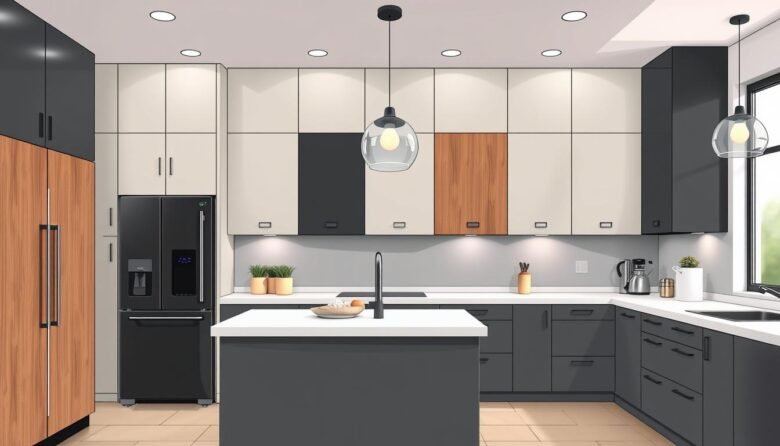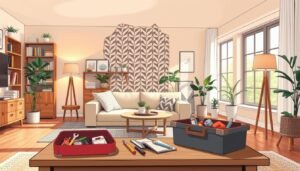MasterBrand’s annual cabinetry design report reveals exciting new directions for home spaces. Based on insights from thousands of designers, this authoritative study shows what homeowners really want.
The era of all-white spaces is fading. Natural wood tones and blended styles are taking center stage. Strategic color applications create fresh, inviting environments.
These approaches can transform your space without a complete overhaul. Simple updates like refinishing and hardware changes deliver dramatic results. New materials and innovative features enhance both function and beauty.
Staying current with design choices boosts your home’s value and enjoyment. This article explores key areas including color shifts, style blends, and material selections.
Key Takeaways
- MasterBrand’s report provides authoritative insights from professional designers
- Natural wood tones are replacing all-white color schemes
- Blended design styles create more personalized spaces
- Strategic updates can refresh cabinets without full replacement
- Current design choices improve functionality and home value
- New materials and features offer both aesthetic and practical benefits
The Shift From White to Natural Wood Tones
A significant transformation is reshaping American homes. For nearly a decade, white dominated cabinet finishes. Now, natural wood tones are taking the lead.
This change reflects a broader move toward warmer, more personal environments. Homeowners seek spaces that feel inviting and unique. Wood grains and stains offer that character.
Light Stains Emerge as Top Choice
Light wood finishes now rank as the number one preference. They create bright, airy rooms that feel spacious. This choice helps smaller areas appear larger.
White oak stands out as a premium selection for these light shades. Red oak provides a similar aesthetic at often lower cost. Both species bring beautiful grain patterns.
These light tones work across various design styles. They pair well with both bold and neutral color palettes. Their versatility makes them a smart long-term investment.
Mid-Tone Stains Gaining Popularity
Medium wood shades are rapidly growing in favor. They offer excellent contrast against light floors or walls. This creates visual interest and depth.
Industry forecasts predict mid-tones will become the preferred option by 2027. Their warmth adds coziness without darkening the room. They bridge traditional and contemporary aesthetics beautifully.
Why White Cabinets Are Declining
After years of dominance, white has fallen to third place in preference. This shift moves away from post-recession conservative styling. People now want more expressive, individualized spaces.
The change represents a cultural movement toward authenticity. Natural materials provide texture and organic beauty. They age gracefully and tell a visual story over time.
MasterBrand’s research shows a 15% increase in color application throughout rooms. This extends beyond accent islands to entire perimeters. Homeowners embrace bolder, more integrated color strategies.
These wood finishes bring both aesthetic and practical benefits. They hide minor wear better than solid colors. Their natural variations mean each installation is truly unique.
Popular Design Styles for Modern Kitchen Cabinets
Contemporary design approaches now favor blended aesthetics over rigid style categories. These combinations create personalized environments that reflect individual tastes.
Stephanie Pierce of MasterBrand notes this shift toward hybrid designs. “Homeowners want spaces that feel uniquely theirs,” she explains. This preference drives the move away from single-style approaches.
Soft Modern: The Leading Choice
Soft modern emerges as the preferred design style for today’s homes. This approach combines clean lines with gentle curves and warm elements.
It balances contemporary simplicity with comfortable warmth. The style features subtle details rather than stark minimalism. This creates inviting spaces that feel both current and cozy.
For cabinetry, this translates to shaker-style doors with softened edges. Brushed nickel or matte black hardware completes the balanced aesthetic. Light wood tones or warm gray finishes enhance the welcoming feel.
Modern Traditional: Blending Eras Beautifully
Modern traditional design merges classical elements with contemporary simplicity. This hybrid approach creates timeless yet fresh environments.
Traditional details like paneled doors get updated with sleek hardware. Classic wood species receive lighter stain treatments. The result honors tradition while feeling completely current.
This style works particularly well in homes with architectural history. It respects original character while introducing modern functionality. The blend feels intentional rather than conflicting.
The Evolution of Farmhouse Style
Farmhouse aesthetics have evolved beyond their peak popularity period. The style now incorporates more subtle, adaptable elements.
Today’s farmhouse influence appears through simple shaker doors and functional hardware. The look emphasizes practicality over decorative excess. White elements remain but often get paired with other materials.
This evolved approach frequently blends with other design styles. It creates spaces that feel lived-in and authentic. The focus shifts from theme to genuine character.
Transitional style has declined significantly from previous years. This reflects moving beyond post-recession design conservatism. Homeowners now embrace more distinctive personal expressions.
These blended approaches allow for creative customization. Mixing door styles within one space creates visual interest. Combining finish colors adds depth and personality.
The versatility of these styles means they adapt to various home architectures. They work equally well in urban lofts and suburban houses. This flexibility makes them excellent long-term investments.
Strategic Color Applications for Cabinet Updates
Color strategy has evolved dramatically in recent years. Homeowners now embrace bolder, more integrated approaches throughout their spaces.
This shift represents increased confidence in personal expression. People want environments that reflect their unique tastes and personalities.
Beyond the Island: Color Throughout the Kitchen
Color application has expanded significantly beyond accent islands. There’s been a 15% increase in colored perimeter cabinetry over two years.
This approach creates more cohesive and intentional environments. It transforms the entire room into a designed statement rather than isolated accents.
The change reflects growing design sophistication among homeowners. They understand how color can define and enhance their living experience.
The Rise of Multiple Finish Combinations
Most spaces now feature at least two different finishes. Many incorporate three, four, or even five complementary treatments.
This layered approach adds visual depth and interest. It allows different zones to have their own character while maintaining harmony.
White and off-white tones often serve as secondary or tertiary colors. This positioning enables more creative and personalized color schemes.
Bold Accent Colors Making Statements
Vibrant hues are making strong appearances in contemporary designs. Bright red, baby blue, and various greens create memorable focal points.
Designer Monika Michałowska demonstrates this with soft mint green cabinetry. She adds striking red accents for dramatic effect.
Rebecca Zajac incorporates green zellige tile as a bold statement. These choices inject personality and energy into the environment.
Successful implementation relies on careful balance and contrast. Homeowners should consider proportion and sight lines when planning.
These strategies offer significant transformation potential without complete renovation. They refresh existing elements while creating entirely new atmospheres.
The movement away from safe neutrals shows growing design confidence. It represents a shift toward more expressive, personalized living spaces.
Premium Materials Defining Modern Cabinet Trends
Material selection plays a crucial role in achieving both aesthetic appeal and long-term durability. The right choices create spaces that stand the test of time while reflecting personal taste.
Today’s homeowners prioritize quality materials that offer beauty and functionality. These selections influence the entire room’s character and daily experience.
White Oak: The Premium Choice
White oak stands as a top-tier selection for discerning homeowners. Its exceptional durability makes it ideal for high-traffic areas.
This material boasts natural resistance to moisture and rot. It accepts light stains beautifully, creating bright, inviting environments.
The distinctive grain pattern adds visual interest without overwhelming the space. Many design professionals recommend it for its timeless appeal.
Walnut and Cherry Wood Alternatives
Walnut offers rich, vibrant tones that make a dramatic statement. Its uniform grain pattern creates a sophisticated, cohesive appearance.
Many designers prefer leaving walnut unpainted to showcase its natural beauty. The deep brown hues add warmth and depth to any environment.
Cherry wood presents attractive reddish-brown undertones that deepen with age. Though slightly softer than oak, it offers excellent workability for custom details.
Both species provide distinctive character that enhances various design approaches. They work well in both traditional and contemporary settings.
Sustainable Material Considerations
Environmental impact has become a significant factor in material selection. White oak’s slow growth rate raises sustainability concerns for some homeowners.
Red oak provides an excellent alternative with similar visual characteristics. Proper staining techniques can achieve appearances nearly identical to white oak.
Other sustainable options include bamboo and reclaimed wood sources. These materials offer ecological benefits without sacrificing luxury or aesthetics.
Durable materials represent smart investments that enhance property value. They withstand daily use while maintaining their beautiful appearance for years.
Consider your budget, preferred style, and environmental priorities when choosing. The right selection creates spaces that feel both personal and purposeful.
Innovative Cabinet Features for a Contemporary Look
Forward-thinking details are reshaping today’s most stylish spaces. These elements combine aesthetic appeal with practical functionality. They offer fresh approaches to personalizing your environment.
Leading designers incorporate these innovations to create distinctive rooms. The features work across various aesthetics from traditional to contemporary. Each option provides unique benefits for homeowners.
Rounded Cabinetry for Softened Aesthetics
Curved profiles are gaining significant attention in current design circles. Studio Johnston demonstrates this approach in modern settings. White Studio & Co applies similar concepts in traditional spaces.
These gentle curves create visual softness throughout the room. They provide excellent flow and movement between different areas. The rounded edges feel both inviting and sophisticated.
This treatment works beautifully on islands and perimeter units. It adds organic shape that contrasts nicely with straight lines. The effect creates a balanced, harmonious atmosphere.
Integrated Appliance Cabinets
Seamless integration represents a growing preference among homeowners. Nina Farmer Interiors showcases refrigerator concealment behind cabinetry. Sarah Sherman Samuel employs similar techniques for other appliances.
This approach creates clean, uncluttered visual lines throughout the space. It allows the room’s design to take center stage. The hidden units maintain full functionality while enhancing aesthetics.
Integrated solutions work with various appliance types and sizes. They provide a custom, high-end appearance without extensive renovation. This feature significantly elevates the overall design impact.
Reeded Details Adding Texture
Textural elements bring depth and character to any environment. Charlotte Lucas incorporates reeded patterns on cabinet fronts. POCO Designs uses similar details on islands and accent pieces.
These vertical grooves create interesting light play and shadow patterns. They add tactile quality that enhances the sensory experience. The detail works across multiple styles from casual to luxurious.
Reeded treatments can also appear on backsplash tiles and other surfaces. They provide organic texture that feels both current and timeless. This feature adds sophistication without overwhelming the space.
These innovative elements offer practical advantages beyond their visual appeal. They improve room flow and reduce visual clutter. The features enhance daily functionality while elevating design.
Homeowners can incorporate these updates through selective refacing or new installations. Many options work with existing layouts and configurations. The changes create significant impact without complete remodeling.
These design choices maintain their appeal over time. They add lasting value and interest to your living environment. The features represent smart investments in both enjoyment and property worth.
Unexpected Elements Enhancing Cabinet Design
Thoughtful details transform ordinary spaces into extraordinary environments. These finishing touches create harmony between different elements throughout the room. They add personality and character that standard installations often lack.
Professional designers incorporate these subtle yet impactful features. Bright Designlab and Anna Haines Designs demonstrate their effectiveness. The elements work across various aesthetics from traditional to contemporary.
Painted Window Trims for Cohesion
Window treatments offer excellent opportunities for visual connection. Matching trim color to cabinetry creates seamless flow throughout the space. This technique unifies different areas into one cohesive design.
Bright Designlab uses this approach to extend color themes beautifully. Anna Haines Designs applies similar strategies for enhanced harmony. The method works with both bold and neutral palettes effectively.
Homeowners can achieve this look with simple paint updates. It requires minimal investment but delivers maximum impact. The change creates professional-level results without extensive renovation.
Statement Stools as Design Accents
Functional pieces can serve double duty as decorative elements. Shapeless Studio selects burgundy stools that complement cabinetry tones. Charlie Ferrer chooses vintage-inspired designs that add character.
These seating options provide visual interest at counter height. They create focal points that draw the eye through the space. The stools offer both practical use and aesthetic appeal.
Select pieces that either match or thoughtfully contrast with existing elements. Consider proportion and scale relative to other features. The right choice enhances rather than overwhelms the overall design.
Exposed Joinery for Artisan Appeal
Visible craftsmanship adds warmth and authenticity to any environment. Rubin Studio showcases joinery details that highlight skilled workmanship. Sarah Sherman Samuel uses similar techniques for custom character.
These elements celebrate traditional woodworking techniques in modern contexts. They provide textural interest that flat surfaces cannot achieve. The details create conversation points throughout the space.
This approach moves away from generic, mass-produced appearances. It embraces personalized touches that reflect individual taste. The result feels both current and timeless in its appeal.
These unexpected details elevate the entire room’s aesthetic. They demonstrate how small choices create significant transformation. The elements work together to create spaces that feel uniquely personal.
Homeowners should balance these accents with existing colors and materials. Too many features can create visual clutter rather than enhancement. Thoughtful selection ensures each element contributes to overall harmony.
The trend toward artisan touches reflects broader design movements. People seek environments that tell stories and showcase character. These details achieve that goal while maintaining functionality.
Implementing These Kitchen Fix Trends in Your Space
Transforming your cooking area with these design approaches requires thoughtful planning and strategic execution. Consider your room’s layout and financial parameters before beginning any project.
Evaluate your existing configuration—whether L-shaped, U-shaped, or G-shaped—to determine optimal updates. Establish a realistic budget that aligns with your goals and explore financing through home equity options or credit lines.
Consulting with a professional remodeler ensures custom solutions tailored to your specific needs. They can help prioritize features like walk-in pantries that might require space reallocation.
Begin with smaller changes like refinishing existing units or updating hardware. These initial steps create noticeable impact while planning larger transformations.
Focus on selections that enhance both daily enjoyment and property value. The right choices create spaces that feel personally meaningful while maintaining broad appeal.
Embrace these opportunities to refresh your environment with current design sensibilities. Thoughtful implementation yields spaces that balance beauty, function, and personal expression perfectly.



